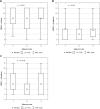Expression differences between proteins responsible for DNA damage repair according to the Gleason grade as a new heterogeneity marker in prostate cancer
- PMID: 37034507
- PMCID: PMC10074180
- DOI: 10.5114/aoms.2019.89773
Expression differences between proteins responsible for DNA damage repair according to the Gleason grade as a new heterogeneity marker in prostate cancer
Abstract
Introduction: The purpose of this research was to explore the correlation between Gleason score and pattern and the expression of the MLH1, MSH2, MDC1, TP53BP1 proteins in prostate cancer (PC). Prostate cancer development is related to errors in DNA, among others double-strand breaks (DSB) and changes in the base sequence of the DNA. These errors should be repaired through mismatch (MMR) or DSB repair proteins such as MSH2, MLH1, MDC1 and TP53BP1.
Material and methods: A total of 500 prostate cancer specimens were recruited in this study. From among all gathered specimens the 52 most suitable cases were selected. The expression of examined proteins was detected by immunohistochemistry, and its correlation with the Gleason score and pattern were further analyzed through standard statistical algorithms.
Results: The results show a significant correlation between Gleason pattern and the nuclear expression of the MSH2 protein and the cytoplasmic expression of the MLH1 protein. Gleason score significantly correlates with the nuclear and the cytoplasmic expression of the MSH2 protein and the cytoplasmic expression of the MDC1 protein. There is no correlation between the nuclear or cytoplasmic expression of the TP53BP1 protein and Gleason pattern or score.
Conclusions: Our study suggests that the aberration in the MMR repair mechanism may be significantly more important regarding the grading among PC cells in comparison to the impact of alterations in the DSB repair mechanism. The lack of correlation between expression of the TP53BP1 protein and Gleason pattern and Gleason score suggests that the radiation resistance of PC is independent of alterations connected with TP53BP1.
Keywords: double-strand breaks; mismatch repair genes; radiotherapy.
Copyright: © 2019 Termedia & Banach.
Conflict of interest statement
The authors declare no conflict of interest.
Figures



Similar articles
-
Loss of DNA mismatch repair proteins in prostate cancer.Medicine (Baltimore). 2020 May;99(19):e20124. doi: 10.1097/MD.0000000000020124. Medicine (Baltimore). 2020. PMID: 32384491 Free PMC article.
-
Interdependence of DNA mismatch repair proteins MLH1 and MSH2 in apoptosis in human colorectal carcinoma cell lines.Mol Cell Biochem. 2016 Jan;412(1-2):297-305. doi: 10.1007/s11010-015-2636-3. Epub 2016 Jan 4. Mol Cell Biochem. 2016. PMID: 26728996
-
The impact of TP53BP1 and MLH1 on metastatic capability in cases of locally advanced prostate cancer and their usefulness in clinical practice.Urol Oncol. 2020 Jun;38(6):600.e17-600.e26. doi: 10.1016/j.urolonc.2020.02.012. Epub 2020 Apr 10. Urol Oncol. 2020. PMID: 32280038
-
The 2014 International Society of Urological Pathology (ISUP) Consensus Conference on Gleason Grading of Prostatic Carcinoma: Definition of Grading Patterns and Proposal for a New Grading System.Am J Surg Pathol. 2016 Feb;40(2):244-52. doi: 10.1097/PAS.0000000000000530. Am J Surg Pathol. 2016. PMID: 26492179 Review.
-
Validity of a two-antibody testing algorithm for mismatch repair deficiency testing in cancer; a systematic literature review and meta-analysis.Mod Pathol. 2022 Dec;35(12):1775-1783. doi: 10.1038/s41379-022-01149-w. Epub 2022 Sep 14. Mod Pathol. 2022. PMID: 36104536 Free PMC article.
Cited by
-
Precision molecular insights for prostate cancer prognosis: tumor immune microenvironment and cell death analysis of senescence-related genes by machine learning and single-cell analysis.Discov Oncol. 2024 Sep 27;15(1):487. doi: 10.1007/s12672-024-01277-6. Discov Oncol. 2024. PMID: 39331250 Free PMC article.
-
Recent Research Advances in Double-Strand Break and Mismatch Repair Defects in Prostate Cancer and Potential Clinical Applications.Cells. 2023 May 12;12(10):1375. doi: 10.3390/cells12101375. Cells. 2023. PMID: 37408208 Free PMC article. Review.
References
-
- Siegel RL, Miller KD, Jemal A. Cancer Statistics, 2017. CA Cancer J Clin 2017; 67: 7-30. - PubMed
-
- Ham WS, Chalfin HJ, Feng Z, et al. . New prostate cancer grading system predicts long-term survival following surgery for Gleason score 8-10 prostate cancer. Eur Urol 2017; 71: 907-12. - PubMed
-
- Humphrey PA, Moch H, Cubilla AL, Ulbright TM, Reuter VE. The 2016 WHO classification of tumours of the urinary system and male genital organs – part B: prostate and bladder tumours. Eur Urol 2016; 70: 106-19. - PubMed
-
- Epstein J, Egevad L, Amin MB, Delahunt B, Srigley JR, Humphrey PA; Grading Committee . The 2014 International Society of Urological Pathology (ISUP) Consensus Conference on Gleason Grading of Prostatic Carcinoma: definition of grading patterns and proposal for a new grading system. Am J Surg Pathol 2016; 40: 244-52. - PubMed
LinkOut - more resources
Full Text Sources
Research Materials
Miscellaneous
